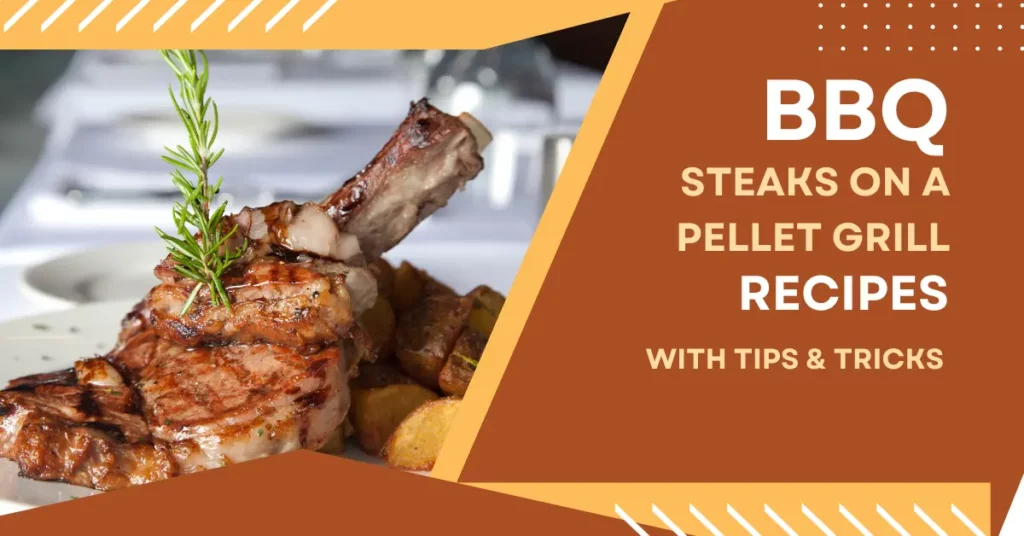This post may contain affiliate links. If you use these links to buy something we may earn a small commission. Thanks.
There’s something undeniably satisfying about the sizzle of a steak hitting a hot grill. When done right, grilling steak is a sensory experience rich aroma, savory sear, and mouthwatering flavor. And with the rise of pellet grills, achieving steakhouse-quality results at home has never been easier.
But here’s the big question: how long should you cook steaks on a pellet grill to get them perfectly done? The answer depends on a few key factors like thickness, cut, grill temperature, and your desired doneness level. In this comprehensive guide, we’ll break it all down and help you master the art of steak grilling on a pellet grill.
Why Pellet Grills Are Perfect for Steaks
Pellet grills combine the precision of an oven with the smoky flavor of traditional grills. They use compressed wood pellets to maintain consistent heat, offering a versatile cooking environment for everything from low-and-slow BBQ to high-heat searing.
When it comes to steak, this duality is a game-changer you can use reverse sear methods for even cooking or high-heat grilling for bold crusts and juicy interiors.

Factors That Influence Steak Cooking Time
There isn’t a one-size-fits-all cooking time for steaks. The duration depends on a few crucial elements:
a. Type of Steak
- Ribeye: Rich in marbling; best at medium-rare to medium.
- New York Strip: Firm, flavorful cut that grills well.
- Filet Mignon: Lean and tender; needs delicate handling.
- Sirloin: Affordable and flavorful, slightly leaner.
- T-Bone or Porterhouse: Combines strip and tenderloin sections.
b. Thickness
- A 1-inch steak cooks much faster than a 2-inch thick cut. Thicker steaks often require indirect cooking followed by a sear.
c. Grill Temperature
- Low heat (225–250°F): Ideal for reverse sear.
- High heat (450–500°F): Perfect for direct grilling and searing.
d. Desired Doneness
Whether you like your steak rare or well-done, internal temperature is the real indicator not just time.
e. Cooking Method
Reverse searing vs traditional searing drastically changes cooking duration and technique. We’ll dive into both methods shortly.
Best Temperature to Cook Steaks on a Pellet Grill
The beauty of pellet grills lies in their precise temperature control. Depending on your preferred method, choose from:
- 225–250°F: For slow cooking or reverse searing.
- 450–500°F: For traditional searing or finishing a reverse-seared steak.
Pro Tip: Start low and finish high for unbeatable flavor and texture.
General Time Guidelines for Steak Doneness
Here’s a quick reference chart to guide you based on a 1-inch thick steak:
| Doneness | Internal Temp | Total Cook Time (approx) |
|---|---|---|
| Rare | 120–125°F | 10–12 minutes |
| Medium-Rare | 130–135°F | 12–14 minutes |
| Medium | 140–145°F | 14–16 minutes |
| Medium-Well | 150–155°F | 16–18 minutes |
| Well-Done | 160°F+ | 18–20 minutes |
Note: Adjust times for thickness. Add 2–3 minutes per side for every 0.5-inch increase.
Reverse Sear Method on a Pellet Grill
The reverse sear is a fan-favorite method for cooking steak on a pellet grill. It involves slow cooking first, then searing at high heat to finish.
Step-by-Step Instructions:
- Preheat the pellet grill to 225°F.
- Place the steaks on the grill grates away from direct heat.
- Cook until the steak reaches about 10–15°F below your target temperature.
- Remove the steak and cover loosely with foil.
- Crank the grill to 450–500°F.
- Once hot, sear each side for 1–2 minutes until a crust forms.
- Remove from the grill and let it rest for 5–10 minutes.
Why Reverse Sear Works So Well:
- More even doneness edge to edge.
- Better control over internal temperature.
- Superior flavor thanks to the finishing sear.
Traditional High-Heat Sear Method
Prefer a quick steak fix? The direct sear method is faster and still delivers delicious results if you time it right.
How to Do It:
- Preheat your pellet grill to 450–500°F.
- Place steaks directly on hot grates.
- Cook 4–6 minutes per side for medium-rare (adjust based on thickness).
- Flip only once to retain juices and achieve nice grill marks.
- Use a thermometer to check internal temp.
- Rest the steak before slicing.
This method works best for thinner steaks (1–1.5 inches) that cook evenly over high heat without overcooking.
How to Tell When Your Steak Is Done
Use a Meat Thermometer (Highly Recommended)
Nothing beats the accuracy of an instant-read thermometer. Here’s a quick guide:
- Rare: 120–125°F
- Medium-Rare: 130–135°F
- Medium: 140–145°F
- Medium-Well: 150–155°F
- Well-Done: 160°F+
Visual and Touch Cues
- Rare: Soft and spongy
- Medium-Rare: Soft with a little bounce
- Medium: Firm but slightly springy
- Well-Done: Very firm
Still, don’t rely solely on touch unless you’re very experienced. A thermometer guarantees consistency.
Pro Tips for Perfect Steaks on a Pellet Grill
- Bring Steak to Room Temp: Let your steak rest at room temperature for 30–45 minutes before grilling for even cooking.
- Season Well: Stick with simple salt and pepper or elevate flavor with dry rubs, marinades, or compound butters.
- Use Wood Pellets for Flavor: Oak, hickory, or mesquite pellets add a deeper smoky profile.
- Avoid Over-Flipping: One flip is often enough.
- Let It Rest: Always let your steak rest after cooking. Resting redistributes the juices and enhances flavor.
Common Mistakes to Avoid
Even experienced grillers can make missteps. Here are a few to avoid:
- Cooking Cold Steaks: This leads to uneven cooking.
- Skipping the Preheat: A cold grill won’t sear properly.
- Overcooking: Trust your thermometer and don’t guess.
- Not Resting Your Steak: Cutting it immediately lets juices escape.
- Ignoring Grill Cleanliness: Dirty grates affect flavor and cause sticking.
Final Thoughts
Cooking steaks on a pellet grill can be incredibly rewarding when you get the timing, temperature, and technique just right. Whether you prefer a slow and steady reverse sear or a quick high-heat grill, your pellet grill has the versatility to deliver restaurant-quality results right in your backyard.
Just remember the golden rules know your doneness level, monitor internal temperature, use quality wood pellets, and let your steak rest. With a little practice and the right approach, you’ll be serving up perfectly cooked steaks that impress every time.
